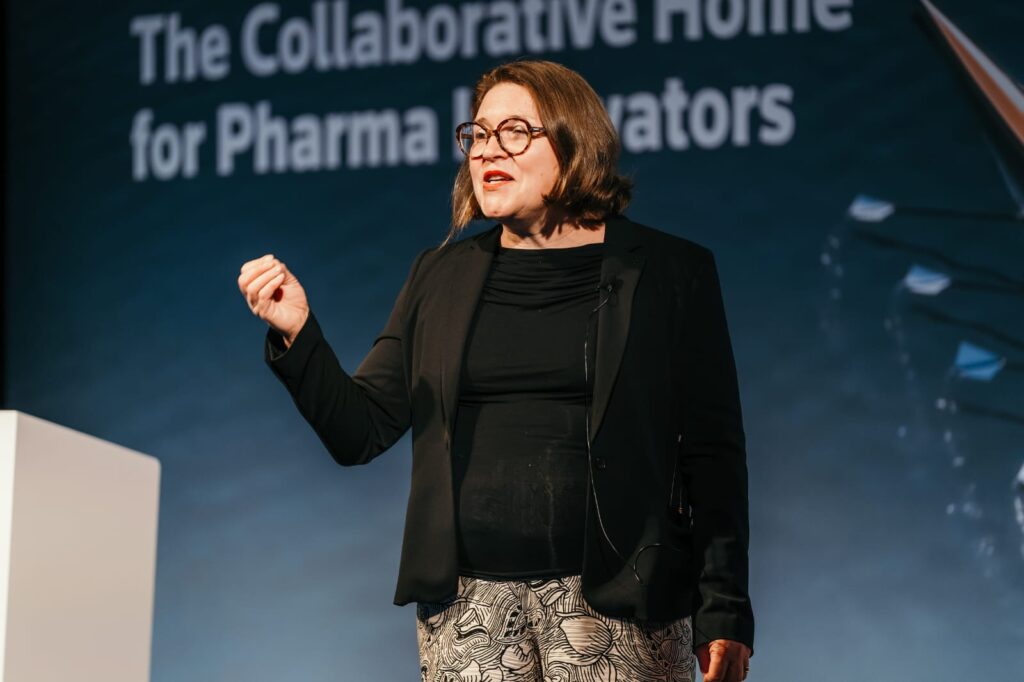AI alone won’t transform your customer engagement. It’s not the hero of the story. You are.
AI is your sidekick. Your superpowered assistant. Helping you decide faster, work smarter, and engage better.
But without human insight, empathy, relevance, and customer context, AI is another tool gathering digital dust. This was the powerful message delivered on stage at Reuters Events Pharma 2025 in Barcelona, where our CEO, Sabine Louët, moderated a panel with some of the most actionable advice Pharma customer engagement managers could have right now—be in from the Medical Affairs of Commercial perspective.
If you’re not already using AI with a purpose, like digital content creation for customer engagement you’re not unlocking its full potential.

Who Took the Stage?
Sabine Louët, CEO SciencePOD – The Guide – Led the conversation with a sharp focus on what matters: customer value.
Nataliya Andreychuk, Co-Founder & CEO Viseven – The Challenger – Boldly reminded us that AI doesn’t lead—humans do.
Berkan Aysan, Global Head of Medical Engagement Excellence & Digital Health NPP Lead, Merck Group – The Practitioner – Brought practical, real-world examples of AI in medical engagement.
Conor Riordan, Director of Customer Service, Pfizer – The Operator – Shared powerful stories of turning AI into commercial results at scale.
Why This Matters More Than Ever
This wasn’t one of those sit-back-and-nod conversations about “AI potential.” It felt more like a wake-up call. Right from the start, Nataliya Andreychuk challenged the room with a simple but powerful truth: “AI isn’t in the driver’s seat—you are.”
Customer expectations have already shifted. Healthcare professionals aren’t waiting for pharma to catch up. They want engagement that feels personal, timely, and relevant across every channel they use, whether that’s a face-to-face meeting or a LinkedIn post they scroll through on their commute. Berkan Aysan called this out perfectly, describing how teams at Merck are working to understand “who the end customer is and what message they need to hear—not just today, but next.”
But it’s not just about messaging.
Conor Riordan brought it back to the grind of daily operations—managing 16,000+ products, forecasting demand across 200 countries, and still getting life-saving medicines delivered on time, in full. And that’s not theory, he made it clear that AI is already making this happen at Pfizer, cutting through data clutter so teams can focus on the exceptions, not the routine.
Still, every speaker circled back to the same reality: AI only works when people know how to work with it. Without human oversight, without asking the right questions, without connecting the dots across medical, commercial, and customer needs, you’re just adding another tool to the tech stack.
And if pharma doesn’t close that gap? “You risk doing more, but achieving less,” as Berkan Aysan put it.
That’s why this conversation mattered. Not as another AI forecast, but as a reminder that what pharma does next, with people, data, and technology, will define the future of healthcare engagement.

Moving from random messaging to real engagement
If there was one thing everyone on stage agreed on, it’s that pharma needs to stop talking at customers and start listening to them.
AI, when done right, can help teams move beyond the old habit of sending the same generic content to every healthcare professional. As Berkan Aysan put it, “We need to understand who’s in front of us, not just their title or specialty, but their behavior, their needs, and the way they like to engage.”
That’s where AI steps in. By collecting and connecting data across every touchpoint, whether it’s an email they opened last month or a question they asked at a live event, AI helps teams build a living, breathing profile of each customer. This turns engagement from a guessing game into a real conversation.

From forecasting to fulfillment – Making global pharma work
Of course, engagement is just one piece of the puzzle. Conor Riordan reminded the audience that in pharma, you don’t just sell messages, you deliver products that millions of people rely on. And managing that scale is no small feat.
Pfizer’s reality? 1.4 billion packs of medicine, shipped to over 200 countries, serving 130,000 customers. Conor Riordan gave us a glimpse behind the scenes, explaining how AI helps Pfizer forecast demand across 16,000+ products, taking the pressure off planners and reducing costly disruptions.
And yes, even in 2025, some hospitals still send their orders by fax. That’s the operational reality pharma lives with every day. AI helps make sure those medicines still arrive on time, because in healthcare, being late isn’t an option.
Connecting data and creativity, closing the gap
Engagement falls flat when data and creativity live in two separate worlds. Nataliya Andreychuk hit this point hard when she explained how AI can help bridge that gap, making sure the content teams create is informed by real customer data.
“It’s not just about pushing content,” she said. “It’s about making it relevant, making it personal, and making sure it lands the right way.”
When teams use AI to connect the dots between what customers care about and how they experience the message, engagement stops feeling like noise and starts driving real impact.
Building smarter teams, not just smarter tools. It was clear from both Merck and Pfizer’s stories that AI isn’t here to replace anyone. It’s here to empower teams to work smarter.
Berkan Aysan shared how Merck is giving its teams co-creation platforms powered by AI, allowing them to build and customize content with confidence. At Pfizer, Conor Riordan showed how AI tools are freeing customer service teams from tedious manual tasks, letting them focus on what they do best, solving real customer problems.
Because the value of AI isn’t in doing the work for you. It’s in helping your people do their best work, faster and smarter.

Seeing the whole Customer, not just the data points
The conversation kept circling back to one big idea: true customer centricity. Not in theory, but in how teams work together.
Berkan Aysan spoke about breaking silos, connecting data across therapeutic areas, and spotting patient-level synergies that no single team could see on their own. Whether it’s building a multi-channel engagement journey or identifying the next best treatment option, AI helps teams zoom out so they can finally see the whole customer, not just fragmented data points.
Doing better, not just doing more
How do we get impact? AI helps pharma do more with less: less waste, less guesswork, and fewer missed opportunities. Whether it’s amplifying what works in marketing or smoothing out the complexities of global supply chains, AI isn’t about adding more to your plate.
It’s about doing better work, with greater value, for the people who need it most.
Let’s talk about how AI can augment your digital content creation capabilities.

